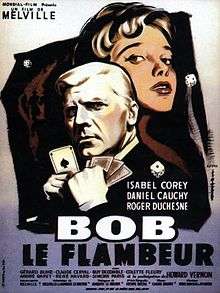Bob le flambeur
| Bob le flambeur | |
|---|---|
 | |
| Directed by | Jean-Pierre Melville |
| Produced by |
|
| Screenplay by | Jean-Pierre Melville[1] |
| Starring |
|
| Music by |
|
| Cinematography | Henri Decaë[1] |
| Edited by | Monique Bonnot[1] |
Production companies |
|
Release dates |
|
Running time | 102 minutes[2] |
| Country | France |
Bob le flambeur ("Bob the Gambler" or "Bob the High Roller") is a 1956 French gangster film directed by Jean-Pierre Melville. The film stars Roger Duchesne as Bob. It is often considered a film noir and precursor to the French New Wave because of its use of handheld camera and a single jump cut.[3]
Plot
Bob, a middle-aged gambler and ex-con living in the Montmartre district of Paris, experiences a run of bad luck that leaves him nearly broke. Bob is a gentleman with scruples, well liked in the demi-monde community. He has unsuccessfully tried to rob a bank in the past, and has spent time in prison.
He hears through a croupier friend that the Deauville Casino holds undreamed-of quantities of cash, vulnerable in the early morning hours. Bob develops a complicated scheme to steal it, bringing in a tough but naive young protégé and an ace safecracker into his scheme, along with a few other underworld characters.
Bob also becomes involved with a young woman, Anne, who does not have her own place and stays with any man who can take her off the streets. Later, Anne begins spending time with Bob's friend and partner-in-crime, Paolo.
Meanwhile, Paolo trusts Anne and tells her the plot in which he is involved with Bob. However, in the evening of the planned heist, Anne betrays the gang to a pimp turned informant, Marc, without realizing that it was supposed to be a secret. Marc tips the possibility of a scheme masterminded by Bob to Inspector Ledru of the local police, whom Bob once saved from death. However, Marc is gunned down by Paulo just as he is about to confirm the specifics.
Ledru searches Bob's Montmartre haunts to warn him off the plan – in vain. At the casino, Bob fails to connect with his inside man, a croupier who has spilled the plan with his wife, who's also tipped off Ledru. An hours-long winning streak preoccupies Bob, a dance with Lady Luck he has waited for all his life. Suddenly, Bob is startled to realize it is the appointed hour of 5:00 AM, hurriedly cashes in a fortune in chips, and exits the casino floor. Just as his gang arrives, Ledru and the police descend, triggering a shooting spree. Bob rushes out of the casino in time to cradle his dying protégé, Paolo, then is arrested and handcuffed as casino employees trundle out stack upon stack of winnings and place them in the trunk of Inspector Ledru's car.
It is strongly implied that his lucky streak will hold, and he will get off with little or no jail time. Possibly, he quips, he will sue the police for damages – while the beautiful Anne waits for him at his apartment.
Principal cast
- Isabelle Corey as Anne
- Daniel Cauchy as Paolo
- Roger Duchesne as Bob Montagné
- Guy Decomble as Insp. Ledru
- André Garet as Roger
Production
Bob le flambeur was shot on location in Paris and Deauville with two interiors at rue Jenner studio.[2] According to an interview the film cost 17.5 million French francs while CNC Censorship file indicates an estimate of 32 million French francs.[2]
Release
Bob le flambeur was released in Paris on 24 April 1956.[2] The film was Melville's lowest grossing at this point in his career.[4] In Paris, the film took in 221,659 admissions and 716,920 admissions in France as a whole.[4]
Critical reception
Vincent Canby, writing for The New York Times in 1981, noted "Melville's affection for American gangster movies may have never been as engagingly and wittily demonstrated as in Bob le Flambeur, which was only the director's fourth film, made before he had access to the bigger budgets and the bigger stars (Jean-Paul Belmondo, Alain Delon) of his later pictures.[5]
The film received positive reviews when re-released by Rialto Pictures in US cinemas in 2001, earning a 96 percent rating on Rotten Tomatoes, a website that collects film reviews.[6]
Remake
Bob le flambeur influenced the two versions of the American film Ocean's Eleven (1960 and 2001) as well as Paul Thomas Anderson's Hard Eight, and was remade by Neil Jordan as The Good Thief in 2002.[7]
References
Footnotes
- 1 2 3 4 5 6 Vincendeau 2003, p. 228.
- 1 2 3 4 Vincendeau 2003, p. 229.
- ↑ Ebert, Roger (May 25, 2003). "Bob le Flambeur (1955) Review". Chicago Sun-Times. Archived from the original on September 16, 2009. Retrieved September 16, 2009.
- 1 2 Vincendeau 2003, p. 260.
- ↑ Canby, Vincent (September 26, 1981). "Bob le Flambeur (1955) Movie Review". The New York Times. Retrieved September 16, 2009.
- ↑ "Bob Le Flambeur (1955)". Rotten Tomatoes. Retrieved September 16, 2009.
- ↑ http://www.film4.com/reviews/2002/the-good-thief
Sources
- Vincendeau, Ginette (2003). Jean-Pierre Melville An American in Paris. British Film Institute. ISBN 0851709494.
External links
- Bob le Flambeur at the Internet Movie Database
- Bob le Flambeur at AllMovie
- Bob le Flambeur at Metacritic
- Criterion Collection essay by Luc Sante
- "Bob le Flambeur", Senses of Cinema, February 2003, Brian Frye